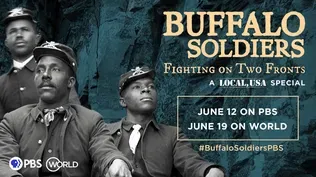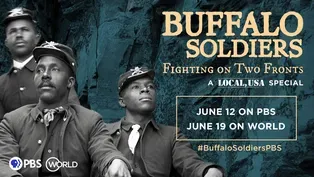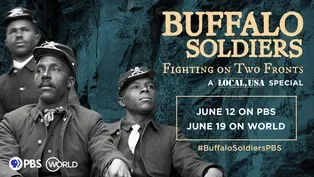
Beyond the Lens with Dru Holley
Clip: Season 7 Episode 4 | 5m 40sVideo has Closed Captions
A conversation with director Dru Holley of BUFFALO SOLDIERS: FIGHTING ON TWO FRONTS.
Filmmaker Dru Holley talks about Buffalo Soldiers: Fighting on Two Fronts, the making of his film, and reveals the catalyst behind it. The director & producer also discusses the complexities of the Buffalo Soldiers and how, although they are a part of American history, their story remains relevant today.
Problems with Closed Captions? Closed Captioning Feedback
Problems with Closed Captions? Closed Captioning Feedback
Funding provided by the Corporation for Public Broadcasting. Additional funding provided by the John D. and Catherine T. MacArthur Foundation, The Wyncote Foundation and the National Endowment for the Arts.

Beyond the Lens with Dru Holley
Clip: Season 7 Episode 4 | 5m 40sVideo has Closed Captions
Filmmaker Dru Holley talks about Buffalo Soldiers: Fighting on Two Fronts, the making of his film, and reveals the catalyst behind it. The director & producer also discusses the complexities of the Buffalo Soldiers and how, although they are a part of American history, their story remains relevant today.
Problems with Closed Captions? Closed Captioning Feedback
How to Watch Local, USA
Local, USA is available to stream on pbs.org and the free PBS App, available on iPhone, Apple TV, Android TV, Android smartphones, Amazon Fire TV, Amazon Fire Tablet, Roku, Samsung Smart TV, and Vizio.
Buy Now
Providing Support for PBS.org
Learn Moreabout PBS online sponsorshipThis is P.J.
This is my favorite horse right here.
(chuckles) We have our marching drills, our rifling drills.
We have an hour of reading, so studying for Buffalo Soldiers' history.
- Back in 2018, I was volunteering at the Juneteenth Festival in Seattle for the Langston Hughes Foundation.
I brought my six-year-old daughter there.
I captured some footage while she checked out the festival.
And after a while I heard her say, "Ooh, horses."
And when I looked up from the camera I seen these brothers straight out of the West, straight out of the 19th century, galloping up the hill on horseback.
And my daughter asked me, "Who are they, Daddy?"
And I couldn't for the life of me remember at that time who these gentlemen were depicting.
The kids that know me from being a inner urban individual and then they see me in my cowboy gear, they're just blown away.
A lot of times they don't even recognize me.
One of the messages that I share with youth is that you have to figure out and learn where you come from.
- I said, "I think those are the Buffalo Soldiers."
I was a little sad that I hade forgotten this history and that my daughter probably wasn't gonna be taught this history.
So I set out on the journey to make this project.
JERRY LAWSON: This story is about a group of soldiers that made up one segment of the United States Cavalry.
To the Indian, this soldier looked strange and different because he wasn't White.
He was Black.
Thick woolly hair, strong.
He sort of reminded the Indian of the great buffalo, so the Indian called this Black Cavalry soldier Buffalo Soldier.
- Buffalo Soldiers were an all-Black regiment, created by Congress in the Reorganization Act of 1866.
They were Black soldiers who were involved in the Indian wars.
These brave Black patriots sacrificed for their country and continue to sacrifice for their country.
This is our country.
This is American history, this is Black history, but this is American history.
Don't put us in this box where we're not celebrated as much as any American is celebrated.
MILLNER: In the narrative of American history, the West has always been this mythical and symbolic place in which heroic deeds were done.
And being capable of great deeds was not something that society was willing to admit that Black people were capable of doing.
And so, as a consequence, when we tell our stories, we leave the Black stories out, and the Buffalo Soldiers were a perfect example of that.
SHINE: The day-to-day work of African American soldiers was escorting supply wagons, helping string telegraph lines, helping protect parties that were surveying locations for railway lines.
Really, the work that they were doing was supporting the American infrastructure moving west of the Mississippi.
All this expansion into the American West is coming at the cost of displacing Native peoples and their life ways.
Who's on the front line of that conflict?
It's largely the Buffalo Soldiers.
- Buffalo Soldiers were involved in the Indian Wars, right, that displaced these native people.
Like, that's hard to wrestle with, right?
How do I tell that story?
And the only way to tell these stories is to tell the the complexities and the truth, right?
To open up conversation.
We'll be doing the justice to the Buffalo Soldiers' history and legacy as well as our Native American brothers' and sisters' legacy and history - The Buffalo Soldiers had the challenge of always fighting on two fronts, fighting the enemy that the commanding officer said you're fighting, and then fighting the commanding officers who didn't think that they were even worthy of wearing the uniform.
- I'm a storyteller and I'm passing on the history.
That's all I can do.
I'm not gonna, I'm not the hider of history, I'm the teller of history.
Some of the creative challenges that we experienced in this film is trying to tell this vast history with no moving images before the turn of the century.
Luckily, we had the Buffalo Soldiers of Seattle Legacy History Group to do the reenactments, which they was great.
This was our third animation style before we landed on this one.
It was a learning experience.
- Telling the story of the Buffalo Soldiers is a means of reestablishing that which was already there.
It's making history ring true.
- My grandfather was an original Buffalo Soldier.
So on a level of pride, it just allows me to continuously share the legacy that my family has developed around the Buffalo Soldiers in general.
- This is one of the first generations of my community that are able to do more than just survive.
Our parents, they had to survive and make sure that we had food on the table, and that we were going to school and that we were safe.
And their parents before that, they fought a lot of injustice in the world.
And we continue to fight that today.
The American dream is recognizing what our parents fought for and being able to not only survive, but but thrive in this community, thrive in this American culture.
Buffalo Soldiers: Fighting on Two Fronts | Preview
Video has Closed Captions
Exploring the often-contradictory role played by Black soldiers in American history. (30s)
Buffalo Soldiers: Fighting on Two Fronts | Trailer
Video has Closed Captions
Exploring the often-contradictory role played by Black soldiers in American history. (1m)
Providing Support for PBS.org
Learn Moreabout PBS online sponsorshipFunding provided by the Corporation for Public Broadcasting. Additional funding provided by the John D. and Catherine T. MacArthur Foundation, The Wyncote Foundation and the National Endowment for the Arts.















